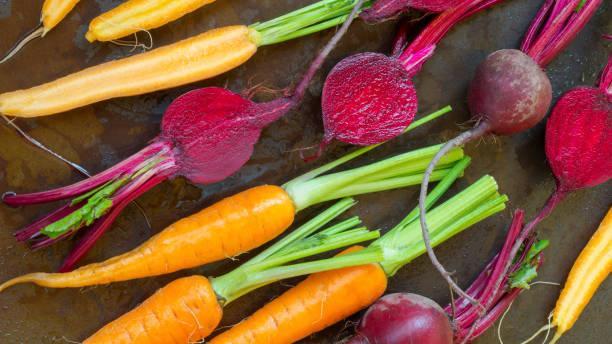A Rainbow on Your Plate: The Health Benefits of Multi-Coloured Carrots

For most of us, the word “carrot” brings to mind the familiar orange kind we grew up with. But walk through a modern farmers’ market or a well-stocked supermarket these days, and you’ll spot bundles of rainbow carrots in every shade imaginable, like deep purple, bright yellow, ruby red, and creamy white. They look almost too pretty to eat, but behind those colours is a surprising amount of nutrition.
When you understand rainbow carrots health benefits, you quickly realise they’re more than a novelty. Each colour comes with its own natural compounds and health perks, giving you an easy, tasty way to add variety to your diet.
Why Rainbow Carrots Deserve a Spot in Your Kitchen
These colourful roots aren’t just visually impressive. Their pigments come from phytonutrients, natural plant compounds that help protect the body from inflammation and oxidative stress. In plain English? Eating a mix of carrot colours gives your body a wider range of vitamins and antioxidants, without changing anything else about your meals.
Put simply: different colours, different benefits.
What Each Colour Brings to the Table
Purple Carrots: Packed With Antioxidants
Purple carrots get their colour from anthocyanins, powerful antioxidants linked to heart health and reduced inflammation. Some research also suggests they support memory and circulation. If you’re trying to add more anti-inflammatory foods to your diet, purple carrots are an easy win.
Orange Carrots: Great for Eyes and Immunity
Orange carrots are rich in beta-carotene, which your body turns into vitamin A. That means stronger immunity, healthier skin, and support for good vision. No wonder orange carrots have been a staple for so long.
Yellow Carrots: Good for Digestion
Yellow carrots contain lutein and xanthophylls, nutrients known for their role in eye health and digestive support. Their lighter flavour makes them lovely for raw salads or gentle roasting.
Red Carrots: Heart-Friendly Lycopene
Red carrots owe their bright colour to lycopene, the same antioxidant found in tomatoes. Lycopene has been linked to heart health and may help reduce the risk of certain cancers. Red carrots offer a crisp, sweeter way to enjoy this nutrient.
White Carrots: Simple but Nourishing
Even without strong pigments, white carrots bring plenty to the table. They’re high in potassium and fibre, which supports digestion and healthy blood pressure. Their mild flavour means they blend beautifully into soups and purees.
How to Add Rainbow Carrots to Everyday Meals
Rainbow carrots are as flexible as the standard orange variety, and a whole lot more fun. You can roast them with olive oil and herbs, steam them, spiralise them, or slice them raw into salads for a crunchy pop of colour. Their natural sweetness works beautifully with balsamic glazes, citrus, honey, or warm spices like cumin and coriander.
And because they brighten up any dish, they’re perfect when you want to impress without much effort.
Try This: Snack-Ready Carrot Crackers
If you’re looking for something different, try making a simple carrot crackers recipe using rainbow carrots. Grate the carrots, mix them with seeds, olive oil, and seasoning, then flatten and bake until crisp. The colourful flecks make the crackers look gorgeous, and they’re perfect with dips, cheese, or tucked into lunchboxes.
Why This Trend Is Worth Trying
Rainbow carrots aren’t a gimmick; they’re an easy way to get more antioxidants, more flavour, and more visual appeal on your plate. Understanding the health benefits helps you make little changes that genuinely enrich your diet.
So next time you’re choosing carrots, skip the usual orange-only bunch and grab a rainbow mix instead. They bring colour, creativity, and nutrition to your meals in the simplest possible way.
- Art
- Causes
- Crafts
- Dance
- Drinks
- Film
- Fitness
- Food
- Jocuri
- Gardening
- Health
- Home
- Literature
- Music
- Networking
- Alte
- Party
- Religion
- Shopping
- Sports
- Theater
- Wellness


